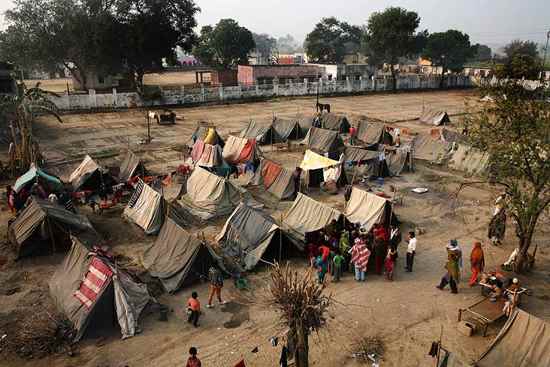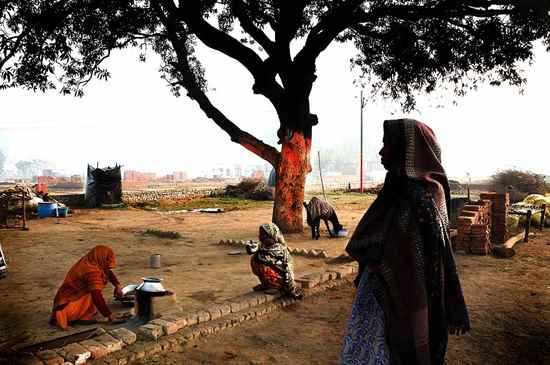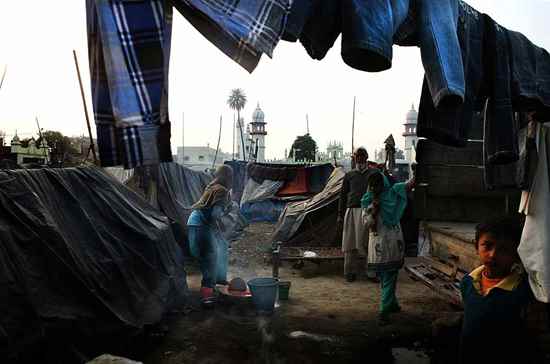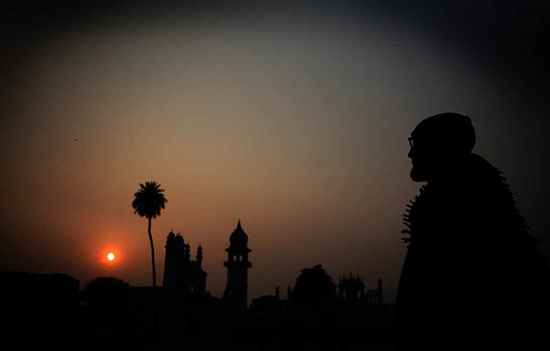Lakh Bawdi, a village in Uttar Pradesh’s Shamli district, 20 km from Muzaffarnagar town, is surrounded on three sides by harvest-ready fields of sugarcane as high as the average Indian, and a pond on the fourth. The joke in north India is that there is no better place to hide an abducted person than in a harvest-ready sugarcane field.
This harvesting season, however, the cane fields in Lakh Bawdi are throwing up tales infinitely more sordid. Like the partially decomposed, half-naked body of a woman found recently. It won’t be the first—more corpses will emerge as the harvesting season progresses.
Lakh Bawdi was among the villages most affected by the sectarian violence in Muzaffarnagar and Shamli districts in September, the others being Lisad, Phugana, Kutba-Kutbi, Kirana, Budhana and Bahawdi.
It’s a scene etched firmly in Abid Khan’s mind. “It was 7.30 in the morning,” recalls the 35-year-old from Lakh Bawdi. “A group of young men stopped outside our house and asked us to run away if we wanted to stay alive. We ran to Billu Pradhan’s house for help.” He is referring to Sudhir Kumar, the elected head of the village, better known as Billu Pradhan.

Lakh Bawdi has a total voting population of 9,500; most of the village’s 1,200 Muslims live beyond the fields, in an area locally called pallipaar, working as agricultural labourers, carpenters, washermen, butchers, tailors. Sugarcane farming, the primary occupation here, is the preserve—and the privilege—of the land-owning Hindu (and a handful of Muslim) Jats.
Billu Pradhan’s is a sprawling mansion. We are constantly asked “not to leave” the pucca road while seeking directions to it. The road’s fairly new, the only metalled one in the village, and ends at the pradhan’s house.
Billu Pradhan’s house has a well-manicured garden; neatly trimmed rose plants line its entrance. Three tractor trolleys are parked to the left, five buffaloes are tied on the right. The building has a separate visitor’s room, with charpoys and hukkahs—markers of Jat identity. There’s a big courtyard in the centre, the one Abid is talking about.To reprise the well-worn back story, things had been tense for a while, since the end of August. Word was a Muslim boy in Kawal village had ‘eve-teased’ a Jat girl (though some say it was a traffic-related incident). Her brother and cousin apparently avenged the slight by killing him, and were in turn allegedly lynched by an irate Muslim mob on the spot. Tempers ran high for days—the air rife with rumour, fake videos and all the modern complements of a riot in the making. Politicians led the chorus as provocative speeches and incitements to violence rent the air at two ‘war councils’: a Muslim congregation after Friday prayers in Muzaffarnagar town, and a Jat mahapanchayat at Kawal on September 7. The following morning, several villages woke up to the news that a Muslim mob had attacked groups of Jats returning from Kawal, killed them and dumped their bodies in the Jauli canal, a Muslim-dominated area. The news reached Lakh Bawdi too. “When we asked Billu Pradhan to protect us, he assured us that nothing would happen,” says Abid. “While some of us collected in his courtyard, others were asked to flee in a different direction.”
Around 30 people, including Abid’s mother and other women from the village, had come here that morning. Abid himself, along with 50 others, including his grandfather and uncle, had taken the route to safety the pradhan had suggested. Except that a mob awaited them there. “My grandfather and uncle were killed in front of my eyes. Me, my father and other family members ran into the sugarcane fields to hide,” Abid recalls. Frantic, he’d called the police on the mobile. “They arrived, but only at 12.30 pm, four hours after everything was over. Around 80 people from my village had been killed by then,” he says. They found Abid’s grandfather’s body on September 8 itself; his mother’s naked and mutilated body was found a day later, in a store heaped with dung cakes. That very day, Abid left for the makeshift camp in Loni in Ghaziabad district, 40 km from the national capital, along with the rest of the family members.
It may be difficult to corroborate the number of dead Abid quotes, but testimonials of several refugees from the village, now in the 16 relief camps in Shamli and Muzaffarnagar districts, leave no doubt of the gruesomeness they encountered.
It’s raining the evening we reach the Idgah camp in Kandhla in Shamli district. A town dominated mostly by Muslims, the refugee camp is being supported largely by donations from locals. Several heaps of donated clothes lie soaked in muddy pools in the compound of the mosque as we enter. Over 12,000 people from the riot-affected villages have taken refuge here. When the rooms in the madrassa couldn’t accommodate them, tents were set up. Except that when the rains came, water leaked through the tents and forced people to stuff themselves in the madrassa’s corridors.
Women occupy the first and ground floors. Sitting with a group of old women is Shabana, a thirtysomething from Lakh Bawdi. The left side of her face is dominated by a giant black-and-blue bruise, and she sits there, medicines given by the camp doctor in hand, the women around her exhorting her to take them. What happened? “My house was burnt, three buffaloes were burnt too and my two sons are missing,” she says, in a tired and practised answer. What’s her name, what are her sons’ names, what happened to her and how did she escape? Again, the same mechanical answer. “My buffaloes were burnt too.” Shabana is too traumatised to provide any immediate answers. After a full hour of reassurances and demonstrated empathy, she recounts what happened to her on September 8.
“They came at eight in the morning, a group of 20 men. I was cooking while my husband, a washerman, was about to leave for work. As soon as we heard the commotion, my husband, two sons and I fled. Even as we were running towards Billu Pradhan’s house, we saw our house being set on fire.” It was in this mayhem that Shabana lost track of her two sons. The couple reached Billu Pradhan’s house and were taken inside the gated compound. “Within half an hour, a group of men from the village entered the compound and attacked us. They hacked my husband right before me.” Was she attacked? Shabana is quiet. I try again. This time, her voice a whisper, she says, “They stripped several of us. Took our honour.”
They first beat them with batons, then stripped them and brutally sodomised them. The men were stripped and simply chopped into pieces. Shabana and several others were thrown out, naked, an hour later.
“I and two other women hid behind a house,” she says. “I don’t remember what happened after that, except that a man from this camp gave me his kurta. He must be here. He is wearing a shirt,” she tells me, seeking him out with her eyes in the water-logged fields the balcony overlooks.

She and other women were rescued in the trolleys Haji Wajid Hasan, chairman of the municipal corporation of the Kandhla block, sent off to the neighbouring villages. “They didn’t have clothes,” says Khurshida, a woman from Kandhla. “None at all.” Locals like her collected clothes from the neighbourhood that very evening. Shabana’s two sons, Tahir, a student of Class 5, and Shahid, who was in Class 2, are still missing. It has been three months.
“My husband was old and a tuberculosis patient,” she tells me. “We thought Billu Pradhan had been the head of the village five times and would help us.” Ajiman and Almiyat were attacked with a sickle on the neck within 15 minutes of entering the pradhan’s house. Sabra looks away as her eyes well up with tears. And your daughters? She purses her lips tight and shakes her head, refusing to say more. When I persist, the tears roll down her cheeks. “How can I tell you?” she says, looking at Saju, her 12-year-old. She then takes me aside, to the extreme corner of the compound. “If I tell anyone, who’ll marry Saju?”
A deep breath and fresh resolve later, she continues, “They first pulled my elder daughter and stripped her. Two boys dragged her to the ground and took turns raping her. Then they grabbed my second daughter and hit her private parts with batons. She started bleeding and was pushed to a corner. They then proceeded to assault the other girls.” “Aapa was engaged and would have gotten married today,” Saju tells me later. That day, when the gates were opened after an hour, Sabra rushed out with Saju and others into the jungles close by. They had to walk a whole day and night to reach Kandhla where the volunteers of the camp there came to their aid. This is where she found Rashid, her elder son, who on that day had gone looking for help, and who is out again today, to the Loni camp in Ghaziabad to look for his two sisters who have been missing since that morning at the pradhan’s house.
It is important to note that the first response at any of these camps to questions of sexual violence is immediate denial. In Gangeru, a small town in Muzaffarnagar district dominated by Shia Muslims, the Arabia-Islam-Hudru-Islam madrassa has provided refuge to over 400 people from the 21 villages nearby. When asked if any of the women here had reported any cases of rape, Mohammed Sanaullah, the head of the seminary, tells me candidly, “Women have been raped and tortured, but it is my sincere advice to forget them. The families of these women will disown them if they come to know that they have spoken about it.”
When I reach the Gangeru camp, a group of women is sitting around Sabiha, who gave birth to her third daughter three days after reaching this camp. I asked them if they knew of any cases of sexual violence, and they all replied in unison, “We fled before it happened. But we know of other women who were brutally raped.” This attribution to other women when talking of sexual violence is consistent across camps. “In Islam, rape is treated like adultery,” Manzar, a local lawyer from the district, had told me earlier. “The women will not talk for fear of being accused of adultery.”
However, even as I am leaving, twentysomething Shama follows me. “How did you know women had been raped,” she asks me. “Women at the other camps told me,” I respond. “It’s true,” she says. “It’s painful to pee and take a dump. I can’t even tell the camp doctor. The women in the camp have given me herbal medicine.”
Shama’s husband Iqbal and his younger brother Tahrir were both killed in Lakh Bawdi on September 8. Her husband ran a horse carriage for a living; it was found burnt at the house when they went there for a visit later.
“I went to Billu Pradhan’s house with my six children,” she recounts. “They twisted both arms of my three-year-old daughter and threw her. They were young boys whom I had fed so many times in my house. When I ran to rescue her, they thrashed me with a baton, then used it to rape me, as they did to four or five other women.”

Shama’s sister Shazia, who has been standing 100 metres away so far, joins us. “Don’t tell anyone about it.” Once Shama and her children were thrown out of the pradhan’s house, they and Shazia, with her seven children, fled. “The men and women from the village watched her naked, bleeding, crying, but no one came forward to help. The women we had assisted during childbirth on several occasions also looked at us blankly,” recalls Shazia.
Her voice is still charred. “When the gates of Billu Pradhan’s house were unlocked, I had no clothes on me. My husband and daughter had hid in a jute sack under a charpoy. We all ran as the Hindu boys chased us. But somehow there was news of the police reaching the village. The boys turned back,” she says, wending her way again through the nightmare, her unslept, baggy eyes turning red. “The police came only two hours later. When we asked them for protection, the police officer tried to arrest my husband for inciting violence. We carefully stepped back and took the way to the highway through the jungles. We later took a trolley that was carrying several other Muslims from our village.” Mehraz is now in the Loni camp and does not want to return to her village ever.“They shouted Musalmanon ki laundiyaon ko rakh lo (keep all the Muslim girls),” recounts Mehraz with a shudder. She too had taken refuge in Billu Pradhan’s house and was, like the others, both witness and victim in this numbing festival of violence and hate. She is among the only few women who answers with an emphatic ‘yes’ when asked about sexual assault. Her breasts were attacked with a sharp trowel. “There were 8-10 boys who seemed to be on a mission. They’d strip a woman, attack her and rape her. Then they’d grab the next one, within minutes. Billu Pradhan had vanished after the first 20 minutes.” Her 12-year-old son had been left behind as Mehraz had fled with her eight-year-old daughter and husband Akbar Qureshi. The house was attacked by a group of 10-15 men and her son burnt alive. His charred body was found later.

Another camp, another horror story. This time it’s Rubeena, in her early 20s, at the Malakpura camp. “There were loudspeakers, Bollywood songs blaring out of them, while they were raping us,” she says. “Some boys were also playing the dhol (a local drum), outside the gate.” Rubeena’s cheek has been bitten off, badly. That morning, her mother had asked her to leave for Billu Pradhan’s house along with her younger sister. She told her she would follow with the rest of the family. “Two men held me by my arms as they bit several parts of my body. Three men raped me then, one after the other,” Rubeena tells me, her expression blank, voice emotionless. Rubeena’s parents and the rest of the family have been missing for the last three months. She also says two women from her village were made to dance naked in the mosque. Has she registered a complaint about what was done to her? “Please don’t tell anyone,” she urges. “How will I live in the camp if I do complain?”
The mosques in the villages stand burnt, vandalised. Ask about the charred Muslim houses in the village, and the stock response is, “They set their own houses on fire for the compensation.” “Hindus respect their culture,” the women add. “They can never dishonour any woman.” Ruling Samajwadi Party leader Pramod Rana told villagers, while addressing them recently, “If the Muslims come back, cooperate with them, but tell them you can’t protect them.”
Billu Pradhan has been absconding since the week after the riots. When we contacted his wife, she refused to talk about the incident or his whereabouts. Till date, only six cases of gangrape and five of rape have been registered. And the list of complainants does not even include the testimonies of Shabana, Mehraz or the others in this story. Based on what the nine women we spoke to have told us, close to 19 women were killed, abducted, raped or sodomised that morning at Billu Pradhan’s house.
Last week, after the body of a half-naked woman was found in Lakh Bawdi’s sugarcane fields, UP state women’s commission chairperson Zarina Usmani confirmed sexual violence on women during the communal riots in Muzaffarnagar, Shamli, Baghpat, Saharanpur and Meerut districts. In an open letter, she urged “women to come forward and register their complaints”. “A majority of the (victimised) women are from the weaker sections and are being threatened to stay silent,” she said. UP home secretary Kamal Saxena, when asked if women had been raped and molested during the riots, said, “No woman has registered a complaint with the police. The police can take action only after getting complaints.”
Patriarchy and communalism. They colluded, once again, on the morning of September 8. At the house of none other than the village head. Billu Pradhan.
(The names of all the rape victims have been changed.)







 meaningless lie.
meaningless lie.

 .
.
 .
.





 .
.

 .
.




 Sonia is known for her sympathy and support to deceitful proselytization. Her party granted the high-security Air Force field to Benny Hinn to hold his healing charade that even Christian Trinity Foundation declared as a fraud. A leader of seventh day Adventist church, Ron Watts was ordered deportation by courts for his illegal activities. He seems to have been blessed by Sonia and continues to live in India. The state Governors she appointed have been consistently rejecting State laws to enact anti-conversion laws to prevent conversion of poor people by allurement
Sonia is known for her sympathy and support to deceitful proselytization. Her party granted the high-security Air Force field to Benny Hinn to hold his healing charade that even Christian Trinity Foundation declared as a fraud. A leader of seventh day Adventist church, Ron Watts was ordered deportation by courts for his illegal activities. He seems to have been blessed by Sonia and continues to live in India. The state Governors she appointed have been consistently rejecting State laws to enact anti-conversion laws to prevent conversion of poor people by allurement .
.






 THE ROYAL SON IN LAW ROBERT VADRA DUKE OF MORADABAD IS EXEMPTED FROM PRE-EMBARKATION SECURITY CHECKS.
THE ROYAL SON IN LAW ROBERT VADRA DUKE OF MORADABAD IS EXEMPTED FROM PRE-EMBARKATION SECURITY CHECKS.


 Contribution towards India
Contribution towards India

 .And then she goes and physically throws out poor Sitaram Kesari (then president of Congress party) from the office. Physically, poor fellow. He has gone to the toilet. His chair was empty, and you know what happened? These congress goons, they went and locked up the toilet and made Sonia occupy that place. And the elderly man cried. This is how she became the Congress President. In the same way as the western armies in the past, would invade other civilizations. Seize power, she seized power in a ‘coup d’toilet’
.And then she goes and physically throws out poor Sitaram Kesari (then president of Congress party) from the office. Physically, poor fellow. He has gone to the toilet. His chair was empty, and you know what happened? These congress goons, they went and locked up the toilet and made Sonia occupy that place. And the elderly man cried. This is how she became the Congress President. In the same way as the western armies in the past, would invade other civilizations. Seize power, she seized power in a ‘coup d’toilet’ .
. This is how every word that she has spoken so far had nothing to do with what she did. Her conduct was the very reverse of her professions.
This is how every word that she has spoken so far had nothing to do with what she did. Her conduct was the very reverse of her professions.

 First confrontation with Indian law
First confrontation with Indian law ”
”
 .
. .
. Five years ago, India was at the crossroads. An ordinary, Italy-born woman had all but grabbed the prime ministerial chair, claiming the support of the majority of Lok Sabha members. The 120-year-old Congress willingly surrendered to the Italian bahu (daughter-in-law) of the dynasty. The oldest party in the country could not find a single individual other than her to lead it and the nation of over a billion people.
Five years ago, India was at the crossroads. An ordinary, Italy-born woman had all but grabbed the prime ministerial chair, claiming the support of the majority of Lok Sabha members. The 120-year-old Congress willingly surrendered to the Italian bahu (daughter-in-law) of the dynasty. The oldest party in the country could not find a single individual other than her to lead it and the nation of over a billion people. .Today, when the nation is once again witnessing the battle of the ballot, every nationalist of every party should ponder whom is he voting? He may be voting for the CPI (M), which ultimately translates into support for Sonia Gandhi, whether directly or indirectly. They may be voting for Laloo Prasad Yadav’s party, which would ultimately strengthen the hands of Sonia Gandhi. They may be voting for the DMK-Ied front whose prime ministerial candidate is Sonia and Sonia alone. They may be electing PDF candidates in J&K but with the same result. The duty of all true nationalists then is to ensure that power does not slip into the hands of someone of foreign origin.
.Today, when the nation is once again witnessing the battle of the ballot, every nationalist of every party should ponder whom is he voting? He may be voting for the CPI (M), which ultimately translates into support for Sonia Gandhi, whether directly or indirectly. They may be voting for Laloo Prasad Yadav’s party, which would ultimately strengthen the hands of Sonia Gandhi. They may be voting for the DMK-Ied front whose prime ministerial candidate is Sonia and Sonia alone. They may be electing PDF candidates in J&K but with the same result. The duty of all true nationalists then is to ensure that power does not slip into the hands of someone of foreign origin.